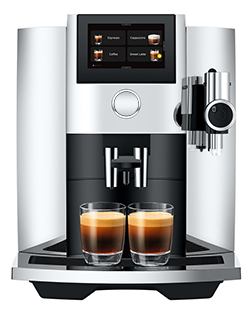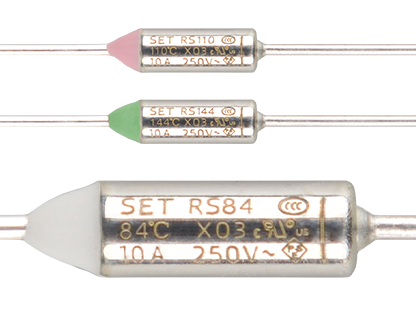Circuit Safety Protection for Coffee Machines SETsafe | SETfuse Solutions and Products
Overview
A Coffee Machine (also known as a Coffee Maker) is a household or commercial appliance designed to brew coffee by heating water and combining it with coffee grounds, capsules, or beans to produce various coffee types, such as espresso, drip coffee, or cold brew. Key features include ease of operation (automatic or manual brewing), multifunctionality (supporting multiple coffee types), smart capabilities (e.g., Wi-Fi or voice control in some models), high-quality taste (meeting professional coffee standards), and eco-friendly design (using recyclable materials or low-power consumption). Coffee machine types include Drip/Filter, Pod/Capsule, Espresso, Bean-to-Cup, and Cold Brew machines.
According to market data, the global coffee machine market is projected to reach USD 18.72 billion (approximately CNY 130 billion) in 2025, with a compound annual growth rate (CAGR) of about 6%. By 2030, the market is expected to grow to USD 25.05 billion (approximately CNY 174 billion), driven by rising household and commercial coffee consumption, advancements in smart technology, and the growing popularity of coffee culture. (Data sourced from the web for reference only.)

Why Coffee Machines Require Circuit Protection Components
Coffee machines, as high-power appliances (typically 800W–2000W), involve hot water (close to 100°C), heating elements, and complex electronic control systems, posing risks such as overheating, overloading, short circuits, and voltage anomalies. These hazards can lead to equipment damage, user injury, or fire risks. Circuit protection components serve the following purposes:
Overheat Protection:
Prevents heating elements (e.g., boilers or heating blocks) from overheating due to malfunctions or prolonged operation, reducing the risk of fire or component burnout.
Overload/Short-Circuit Protection:
Limits excessive current or short circuits, safeguarding critical components like circuit boards, pumps, and motors, and preventing equipment damage or electric shock.
Voltage Anomaly Protection:
Mitigates power supply voltage fluctuations (e.g., surges or overvoltages), protecting sensitive electronic components like control chips.
Enhanced Safety and Longevity:
Disconnects abnormal circuits promptly, reducing safety risks and extending the coffee machine’s lifespan.
National and International Standards
Coffee machine circuit protection designs must comply with national and international safety standards to ensure product safety and market access. Key mandatory standards include:
Chinese National Standards
GB 4706.1-2005:
Requires coffee machines to include overheat and overload protection devices. Circuit protection components (e.g., thermal fuses, fuses) must pass high-temperature and short-circuit tests to ensure rapid response and power disconnection.
GB 4706.19:
For liquid-heating appliances like coffee machines, mandates overheat protection devices (e.g., thermal fuses) to prevent boiler or heating element overheating.
CCC Certification:
Coffee machines fall under China’s Compulsory Certification (CCC) scope and must incorporate compliant circuit protection devices to be sold in the market.
International Standards
IEC 60335-2-15:
Requires circuit protection components (e.g., thermal fuses) to disconnect power quickly during abnormal operation (e.g., heating element failure or pump blockage) to prevent overheating or fires.
UL 1082 (U.S.):
For household coffee machines, mandates overheat and overload protection devices, with circuit protection components passing high-temperature and short-circuit tests for safety and reliability.
CE Certification (EU):
Compliance with the Low Voltage Directive (LVD) and Electromagnetic Compatibility Directive (EMC) requires coffee machines to have reliable circuit protection mechanisms for safe operation under abnormal electrical conditions.
Mandatory Requirements
In China, CCC certification mandates overheat and overload protection devices (e.g., thermal fuses, fuses) to ensure product safety.
For international markets, compliance with IEC, UL, or CE standards is essential for market entry in Europe and the U.S. Circuit protection components must pass rigorous tests to prove effective protection under abnormal conditions.
Due to high-temperature, high-power operation and complex electronic controls, coffee machines require circuit protection components (e.g., thermal fuses, fuses, thermistors) to mitigate risks like overheating, overloading, short circuits, and voltage anomalies, ensuring equipment and user safety. Compliance with national and international standards (e.g., GB 4706.1, IEC 60335-2-15, UL 1082) is mandatory for legal market entry, ensuring safety and reliability while reducing risks and enhancing user trust.
Necessity and Mechanism of Disposable Thermal-Link (Thermal Fuse) in Coffee Machines
Why Disposable Thermal-Link (Thermal Fuse) Is Necessary for Circuit Protection
Coffee machines, operating at high power (800W–2000W) and handling hot water (near 100°C) with heating elements (e.g., boilers or heating blocks), face risks of abnormal temperature increases due to malfunctions (e.g., pump blockages, heating element overheating, or insufficient heat dissipation) or user errors (e.g., dry operation or prolonged use). These risks can lead to fires, component burnout, or user scalding. A Disposable Thermal-Link (Thermal Fuse) is a non-resettable thermal protection device designed for extreme overheating scenarios. When the temperature exceeds a safe threshold (typically 120°C–200°C, depending on the model), the Thermal-Link permanently disconnects the circuit, stopping the device to prevent hazards. Unlike resettable devices, its disposable design ensures faults are not overlooked due to temporary cooling, offering higher safety and reliability.
The use of Disposable Thermal-Link for circuit protection provides reliable, definitive safety assurance in overheating scenarios, preventing fires, equipment damage, or user injury. Installed in series between the power supply and heating elements or control circuit boards, typically near high-temperature areas (e.g., boilers or heating blocks), the Thermal-Link uses a low-melting-point alloy to rapidly disconnect power. Its disposable design ensures faults are isolated, meeting the safety demands of high-power, high-temperature coffee machine operations and serving as a critical measure for equipment and user safety.
Key Functions of Disposable Thermal-Link in Coffee Machines
Overheat Protection:
When internal temperatures exceed safe thresholds (e.g., boiler overheating or abnormal circuit board temperature rise), the Thermal-Link fuses, disconnecting power to prevent fires or component damage.
Permanent Power Disconnection:
After fusing, the circuit cannot be restored, forcing the device to stop and prompting users or technicians to inspect and resolve faults, preventing persistent hazards.
Enhanced Safety:
Protects users from scalding, fires, or electric shock caused by overheating while safeguarding critical components (e.g., boilers, pumps, circuit boards), extending equipment lifespan.
Circuits and Components in Coffee Machines That May Use Disposable Thermal-Link (Thermal Fuse) for Over-Temperature Protection (For Reference Only)
| Heating Element (Heating Tube/Boiler)
| Steam Generator
| Water Pump Circuit
| Control Circuit Board
| Hot Water Distribution System
Installation of Thermal-Link in Coffee Machine Circuits
Installation Locations:
Typically placed near high-temperature areas to accurately detect overheating, including:
Near heating elements (e.g., boilers, heating blocks, or heating tubes) to monitor operating temperatures.
Near water systems (e.g., pumps or heating pipes) to detect abnormal high temperatures.
Near control circuit boards to protect electronic components from heat damage.
Circuit Connection:
Series Design:
The Thermal-Link is typically connected in series with the power supply or heating circuit to ensure disconnection of critical power paths during overheating.
Working Principle:
The Thermal-Link contains a low-melting-point alloy or thermal-sensitive material. When the temperature reaches the preset threshold, the alloy melts or the material breaks, permanently opening the circuit. The fusing response time is typically within seconds, rapidly disconnecting power to prevent worsening conditions. After fusing, the coffee machine stops, requiring replacement of the Thermal-Link to restore operation.
SETsafe | SETfuse Solutions,Products

Protection Type: Over-Temperature Protection
Product Name:
Disposable Thermal-Link (Organic Type OTCO)
Series:
Axial Lead Type RS Learn more
Axial Lead Type RT Learn more
Product Name:
Disposable Thermal-Link (Alloy Type ATCO)
Series:
Radial Lead Type SK Learn more
Radial Lead Type TK Learn more
Radial Lead Type TY Learn more
Radial Lead Type K Learn more
Radial Lead Type X Learn more
Radial Lead Type Y Learn more
Other Circuit Protection Components Used in Coffee Machines and Their Functions
In addition to Disposable Thermal-Links (for extreme overheating), coffee machines employ other circuit protection components to address risks like overheating, overloading, short circuits, and voltage anomalies, ensuring equipment and user safety. Key components and their functions include:
Fuse
Overload Protection: When circuit current exceeds the rated value (e.g., due to overloading or short circuits), the fuse’s metal wire melts, disconnecting the circuit to prevent wire overheating or fires.
Short-Circuit Protection: Rapidly disconnects during short circuits, protecting critical components like control circuit boards, pumps, or motors from high-current damage.
Varistor
Overvoltage Protection: Absorbs voltage surges (e.g., from lightning or grid fluctuations), protecting control circuit boards and sensitive electronic components from overvoltage damage. Varistors are primarily used for surge protection, diverting excessive voltage to ground during transient spikes (e.g., from lightning or switching operations).
Transient Voltage Suppressor (TVS) Diode
Overvoltage Protection: Suppresses transient overvoltages with faster response times and more precise clamping voltages than varistors. Commonly used to protect sensitive electronic components (e.g., microprocessors, sensors) from surge damage, ensuring normal operation.
Summary
In addition to Disposable Thermal-Links (for extreme overheating), coffee machines rely on fuses (for overload/short-circuit protection), thermistors (for temperature monitoring and regulation), varistors (for overvoltage protection), overload protectors (for dynamic overload protection), circuit breakers (for overload/short-circuit protection in high-end models), EMI filters (for electromagnetic compatibility), and grounding protection (for leakage prevention). These components provide multi-layered protection against various circuit risks, ensuring the safety and reliability of coffee machines under high-temperature, high-power operation. Compliance with national and international standards (e.g., GB 4706.1, IEC 60335-2-15, UL 1082) is mandatory for legal market entry, enhancing safety and reliability while meeting regulatory requirements.
Why Choose SETsafe | SETfuse Thermal-Links
| Product Manufacturing: Fully Automated Intelligent Manufacturing.
| Complete Specifications: Maximum Rated Current Up to 30 A.
| Guaranteed Quality: Product Functionality, Performance, and Reliability are Verified.
15 More items than national standards: 30 reliability test items, Including Mechanical, Electrical, Temperature, Soldering, Environmental, and Life Tests.
41.67 Times Higher Than National Standards: Holding Temperature Test Duration is 1,000 hours (National Standard: 24 hours).
2.5 Times Higher Than National Standards: Operating Temperature Accuracy is ±2°C (National Standard: 0/-10°C).
| Multi-System Certifications: Learn more
| Environmentally Friendly Products: HSF (Compliant with RoHS 3.0, REACH, Halogen-Free) Learn more
| Diverse Industry Applications: Learn more
Company Expertise
| Over 25 years of professional design, manufacturing, and sales of circuit protection components. Our products are sold in over 40 countries, and many Fortune 500 companies choose SETsafe | SETfuse. Learn more
Guaranteed, Worry-Free Service
| Pre-sales, in-sales, and after-sales support with professional personnel (feedback within 1 hour) Learn more
Partner with SETsafe | SETfuse to Transform Technical Challenges into Reliable Solutions
When you encounter technical challenges in selecting circuit protection components or designing system solutions, the professional engineering team at SETsafe | SETfuse is your trusted partner. Specializing in over-temperature, over-current, over-voltage, and active protection technologies, SETsafe | SETfuse offers comprehensive technical expertise and rapid response to meet your needs. Whether you require precise product parameter guidance or comprehensive system-level protection solutions, SETsafe | SETfuse delivers professional, practical, and efficient recommendations and support.
From initial design consultation and solution implementation to post-sales product assurance, we provide end-to-end collaboration, ensuring your project progresses seamlessly and reliably. For any inquiries or requirements, please contact us at: sales@SETfuse.com
Professional Circuit Protection, Supporting You from Concept to Production


































 Rechargeable Battery
Rechargeable Battery Lithium Battery Thermal Runaway
Lithium Battery Thermal Runaway Electric Power Tool
Electric Power Tool New Energy
New Energy PV Power Generation
PV Power Generation Wind Power Generation
Wind Power Generation Energy Storage Batteries
Energy Storage Batteries Energy Storage System (ESS)
Energy Storage System (ESS) Electric Vehicles
Electric Vehicles EV Charging Stations
EV Charging Stations Light Electric Vehicles
Light Electric Vehicles Home Appliances
Home Appliances Small Household Appliances
Small Household Appliances Large Home Appliance
Large Home Appliance Home Appliance Component
Home Appliance Component Kitchen Appliances (Hotplates ...)
Kitchen Appliances (Hotplates ...) Air Fryer
Air Fryer Coffee Machine
Coffee Machine Electric Iron
Electric Iron Smart Toilet
Smart Toilet Personal Digital Products
Personal Digital Products Lifestyle Appliances
Lifestyle Appliances Office Equipment
Office Equipment Walkie Talkie
Walkie Talkie Medical Analysis Instrument
Medical Analysis Instrument Medical Auxiliary Facility
Medical Auxiliary Facility Medical Instrument
Medical Instrument Lighting
Lighting Indoor Lighting
Indoor Lighting Outdoor Streetlight
Outdoor Streetlight Power Supply
Power Supply Power Supply (Power < 20 Watts)
Power Supply (Power < 20 Watts) HVDC in Data Centers
HVDC in Data Centers Power Supply Unit (PSU)
Power Supply Unit (PSU) Battery Backup Unit (BBU)
Battery Backup Unit (BBU) Uninterruptible Power Supply (UPS)
Uninterruptible Power Supply (UPS) Telecommunication
Telecommunication Automotive
Automotive Power Strip
Power Strip Surge Protection Power Strip
Surge Protection Power Strip Security & Protection
Security & Protection Tethered Drone
Tethered Drone Industrial Robot
Industrial Robot Humanoid Robot
Humanoid Robot Service Robot
Service Robot Specialty Robot
Specialty Robot Agricultural Irrigation Equipment
Agricultural Irrigation Equipment Smart Agricultural Greenhouse
Smart Agricultural Greenhouse Rail Transit Facility
Rail Transit Facility Rail-Vehicle
Rail-Vehicle Railway Power Supply
Railway Power Supply Fuel Dispenser
Fuel Dispenser Traffic Control System
Traffic Control System Traffic Signal Light
Traffic Signal Light Commercial Cleaning Equipment
Commercial Cleaning Equipment Delivery Locker (Drone)
Delivery Locker (Drone) Vending Machine
Vending Machine Lightning Protection Components
Lightning Protection Components HVAC Rooftop Systems
HVAC Rooftop Systems Outdoor Electric Wall Mounted Heater
Outdoor Electric Wall Mounted Heater Flag Explain
Flag Explain





































